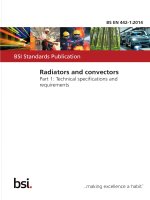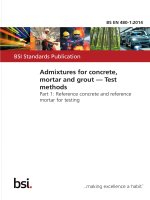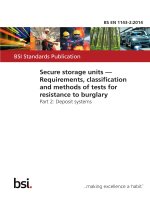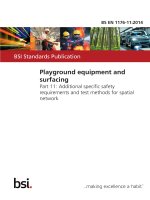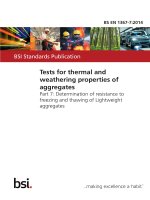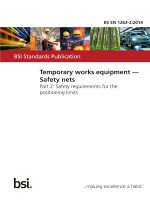Bsi bs en 61534 22 2014
Bạn đang xem bản rút gọn của tài liệu. Xem và tải ngay bản đầy đủ của tài liệu tại đây (1.78 MB, 28 trang )
BS EN 61534-22:2014
BSI Standards Publication
Powertrack systems —
Part 22: Particular requirements for powertrack
systems intended for on floor or underfloor
installation
BRITISH STANDARD
BS EN 61534-22:2014
National foreword
This British Standard is the UK implementation of EN 61534-22:2014. It is
identical to IEC 61534-22:2014. It supersedes BS EN 61534-22:2009,
which is withdrawn.
The UK participation in its preparation was entrusted to Technical
Committee PEL/213, Cable management.
A list of organizations represented on this committee can be obtained on
request to its secretary.
This publication does not purport to include all the necessary provisions of
a contract. Users are responsible for its correct application.
The British Standards Institution 2014.
Published by BSI Standards Limited 2014
ISBN 978 0 580 80752 7
ICS 29.060.10; 29.120.20
Compliance with a British Standard cannot confer immunity from
legal obligations.
This British Standard was published under the authority of the Standards
Policy and Strategy Committee on 30 September 2014.
Amendments/corrigenda issued since publication
Date
Text affected
EUROPEAN STANDARD
EN 61534-22
NORME EUROPÉENNE
EUROPÄISCHE NORM
August 2014
ICS 29.120.20; 29.060.10
English Version
Powertrack systems - Part 22: Particular requirements for
powertrack systems intended for onfloor or underfloor installation
(IEC 61534-22:2014)
Systèmes de conducteurs préfabriqués - Partie 22:
Exigences particulières pour les systèmes de conducteurs
préfabriqués destinés au montage sur le sol ou sous le sol
(CEI 61534-22:2014)
Stromschienensysteme - Teil 22: Besondere Anforderungen
für Stromschienensysteme für Fußbodeninstallationen
(IEC 61534-22:2014)
This European Standard was approved by CENELEC on 2014-07-24. CENELEC members are bound to comply with the CEN/CENELEC
Internal Regulations which stipulate the conditions for giving this European Standard the status of a national standard without any alteration.
Up-to-date lists and bibliographical references concerning such national standards may be obtained on application to the CEN-CENELEC
Management Centre or to any CENELEC member.
This European Standard exists in three official versions (English, French, German). A version in any other language made by translation
under the responsibility of a CENELEC member into its own language and notified to the CEN-CENELEC Management Centre has the
same status as the official versions.
CENELEC members are the national electrotechnical committees of Austria, Belgium, Bulgaria, Croatia, Cyprus, the Czech Republic,
Denmark, Estonia, Finland, Former Yugoslav Republic of Macedonia, France, Germany, Greece, Hungary, Iceland, Ireland, Italy, Latvia,
Lithuania, Luxembourg, Malta, the Netherlands, Norway, Poland, Portugal, Romania, Slovakia, Slovenia, Spain, Sweden, Switzerland,
Turkey and the United Kingdom.
European Committee for Electrotechnical Standardization
Comité Européen de Normalisation Electrotechnique
Europäisches Komitee für Elektrotechnische Normung
CEN-CENELEC Management Centre: Avenue Marnix 17, B-1000 Brussels
© 2014 CENELEC All rights of exploitation in any form and by any means reserved worldwide for CENELEC Members.
Ref. No. EN 61534-22:2014 E
BS EN 61534-22:2014
EN 61534-22:2014 (E)
-2-
Foreword
The text of document 23A/702/FDIS, future edition 2 of IEC 61534-22, prepared by SC 23A "Cable
management systems", of IEC/TC 23 "Electrical accessories" was submitted to the IEC-CENELEC
parallel vote and approved by CENELEC as EN 61534-22:2014.
The following dates are fixed:
–
latest date by which the document has to be implemented at
national level by publication of an identical national
standard or by endorsement
(dop)
2015-04-24
–
latest date by which the national standards conflicting with
the document have to be withdrawn
(dow)
2017-07-24
This document supersedes EN 61534-22:2009.
Attention is drawn to the possibility that some of the elements of this document may be the subject of
patent rights. CENELEC [and/or CEN] shall not be held responsible for identifying any or all such
patent rights.
This standard covers the Principle Elements of the Safety Objectives for Electrical Equipment
Designed for Use within Certain Voltage Limits (LVD - 2006/95/EC).
Endorsement notice
The text of the International Standard IEC 61534-22:2014 was approved by CENELEC as a European
Standard without any modification.
BS EN 61534-22:2014
EN 61534-22:2014 (E)
-3-
Annex ZA
(normative)
Normative references to international publications
with their corresponding European publications
The following documents, in whole or in part, are normatively referenced in this document and are
indispensable for its application. For dated references, only the edition cited applies. For undated
references, the latest edition of the referenced document (including any amendments) applies.
NOTE 1
When an International Publication has been modified by common modifications, indicated by (mod),
the relevant EN/HD applies.
NOTE 2
Up-to-date information on the latest versions of the European Standards listed in this annex is
available here: www.cenelec.eu.
Publication
Year
Title
EN/HD
Year
IEC 61534-1
+ A1
2011
2014
Powertrack systems Part 1: General requirements
EN 61534-1
+ A1
2011
2014
BS EN 61534-22:2014
61534-22 © IEC:2014
–2–
CONTENTS
FOREWORD ........................................................................................................................... 3
1
Scope .............................................................................................................................. 5
2
Normative references ...................................................................................................... 5
3
Terms and definitions ...................................................................................................... 5
4
General requirements ...................................................................................................... 6
5
General notes on tests .................................................................................................... 6
6
Ratings ............................................................................................................................ 6
7
Classification ................................................................................................................... 6
8
Marking and documentation ............................................................................................. 7
9
Construction .................................................................................................................... 8
10
Clearances, creepage distances and solid insulation ....................................................... 9
11
Protection against electric shock ..................................................................................... 9
12
Terminals and terminations .............................................................................................. 9
13
Screws, current-carrying parts and connections ............................................................... 9
14
Mechanical strength ........................................................................................................ 9
15
Insulation resistance test and dielectric strength test ..................................................... 17
16
Normal operation ........................................................................................................... 17
17
Temperature rise ........................................................................................................... 17
18
Short-circuit protection and short-circuit withstand strength ........................................... 17
19
Resistance to heat ......................................................................................................... 17
20
Fire hazard .................................................................................................................... 17
21
External influences ........................................................................................................ 18
22
Electromagnetic compatibility ........................................................................................ 18
Annex AA (informative) Illustrations of underfloor and onfloor installations........................... 19
Annex BB (normative) Additional test requirements for PT systems already complying
with IEC 61534-22: 2009 ....................................................................................................... 21
Figure 101 – External load test ............................................................................................. 10
Figure 102 – Traffic load test for flushfloor service units applied to a small surface
area 13
Figure 103 – Traffic load test for flushfloor service units applied to a large surface
area 15
Figure 104 – Test arrangement for fixing apparatus mounting device according to
14.101.6.1 ............................................................................................................................ 16
Figure AA.1 – Illustrations of underfloor installations ............................................................. 19
Figure AA.2 – Example of installation onfloor ........................................................................ 20
–3–
BS EN 61534-22:2014
61534-22 © IEC:2014
INTERNATIONAL ELECTROTECHNICAL COMMISSION
____________
POWERTRACK SYSTEMS –
Part 22: Particular requirements for powertrack
systems intended for onfloor or underfloor installation
FOREWORD
1) The International Electrotechnical Commission (IEC) is a worldwide organization for standardization comprising
all national electrotechnical committees (IEC National Committees). The object of IEC is to promote
international co-operation on all questions concerning standardization in the electrical and electronic fields. To
this end and in addition to other activities, IEC publishes International Standards, Technical Specifications,
Technical Reports, Publicly Available Specifications (PAS) and Guides (hereafter referred to as “IEC
Publication(s)”). Their preparation is entrusted to technical committees; any IEC National Committee interested
in the subject dealt with may participate in this preparatory work. International, governmental and nongovernmental organizations liaising with the IEC also participate in this preparation. IEC collaborates closely
with the International Organization for Standardization (ISO) in accordance with conditions determined by
agreement between the two organizations.
2) The formal decisions or agreements of IEC on technical matters express, as nearly as possible, an international
consensus of opinion on the relevant subjects since each technical committee has representation from all
interested IEC National Committees.
3) IEC Publications have the form of recommendations for international use and are accepted by IEC National
Committees in that sense. While all reasonable efforts are made to ensure that the technical content of IEC
Publications is accurate, IEC cannot be held responsible for the way in which they are used or for any
misinterpretation by any end user.
4) In order to promote international uniformity, IEC National Committees undertake to apply IEC Publications
transparently to the maximum extent possible in their national and regional publications. Any divergence
between any IEC Publication and the corresponding national or regional publication shall be clearly indicated in
the latter.
5) IEC itself does not provide any attestation of conformity. Independent certification bodies provide conformity
assessment services and, in some areas, access to IEC marks of conformity. IEC is not responsible for any
services carried out by independent certification bodies.
6) All users should ensure that they have the latest edition of this publication.
7) No liability shall attach to IEC or its directors, employees, servants or agents including individual experts and
members of its technical committees and IEC National Committees for any personal injury, property damage or
other damage of any nature whatsoever, whether direct or indirect, or for costs (including legal fees) and
expenses arising out of the publication, use of, or reliance upon, this IEC Publication or any other IEC
Publications.
8) Attention is drawn to the Normative references cited in this publication. Use of the referenced publications is
indispensable for the correct application of this publication.
9) Attention is drawn to the possibility that some of the elements of this IEC Publication may be the subject of
patent rights. IEC shall not be held responsible for identifying any or all such patent rights.
International Standard IEC 61534-22 has been prepared by subcommittee 23A: Cable
management systems, of IEC Technical Committee 23: Electrical accessories.
This second edition cancels and replaces the first edition published in 2009. This edition
constitutes a technical revision.
This edition includes the following significant technical changes with respect to the previous
edition:
•
Clauses 18 to 22 have been adapted to IEC 61534-1:2011 and include short-circuit test
requirements;
•
addition of a new (500 N) classification for the resistance to traffic load applied to small
surface areas on a flushfloor service unit;
BS EN 61534-22:2014
61534-22 â IEC:2014
4
ã
addition of a new classification for the non-automatic closing of the lid on flushfloor service
units and appropriate tests;
•
addition of tests for floor service units declared for use when a floor is wet-treated.
The text of this standard is based on the following documents:
FDIS
Report on voting
23A/702/FDIS
23A/708/RVD
Full information on the voting for the approval of this standard can be found in the report on
voting indicated in the above table.
This publication has been drafted in accordance with the ISO/IEC Directives, Part 2.
This standard is to be used in conjunction with IEC 61534-1:2011, Powertrack systems –
Part 1: General requirements.
This Part 22 supplements or modifies the corresponding clauses of IEC 61534-1. Where a
particular clause or subclause of IEC 61534-1:2011 is not mentioned in this Part 22, that
clause or subclause applies as far as is reasonable. Where this Part 22 states "addition" or
"replacement", the relevant text of IEC 61534-1:2011 is to be adapted accordingly.
Subclauses, tables and figures which are in addition to those in IEC 61534-1:2011 are
numbered starting with 101.
A list of all parts of IEC 61534 series, published under the general title Powertrack systems,
can be found on the IEC website.
The following differences exist in the countries indicated below:
Subclause 7.105.2: In the United Kingdom, this classification is not permitted.
The committee has decided that the contents of this publication will remain unchanged until
the stability date indicated on the IEC web site under "" in the data
related to the specific publication. At this date, the publication will be
•
reconfirmed,
•
withdrawn,
•
replaced by a revised edition, or
•
amended.
–5–
BS EN 61534-22:2014
61534-22 © IEC:2014
POWERTRACK SYSTEMS –
Part 22: Particular requirements for powertrack
systems intended for onfloor or underfloor installation
1
Scope
Clause 1 of IEC 61534-1:2011 and IEC 61534-1:2011/AMD1:2014 is applicable except as
follows:
1.1
Addition:
This part of IEC 61534 specifies the particular requirements and tests for PT systems
intended for mounting on, or under the floor level and floor service units which are mounted
on the floor, under the floor or flush with the floor.
NOTE 1
Types and applications are shown in Figures AA.1a, AA.1b and AA.2
NOTE 2
Flushfloor PT systems, with the exception of flushfloor service units, are not covered by this standard.
2
Normative references
Clause 2 of IEC 61534-1:2011 is applicable except as follows:
Addition:
IEC 61534-1:2011, Powertrack systems – Part 1: General requirements
IEC 61534-1:2011/AMD1:2014
3
Terms and definitions
Clause 3 of IEC 61534-1:2011 and IEC 61534-1:2011/AMD1:2014
follows:
is applicable except as
Additional terms and definitions:
3.101
underfloor PT system
PT system whose components, except flushfloor service units, are intended for installation
beneath the finished floor and in normal use are not exposed to traffic loads
Examples are shown in Figures AA.1a and AA.1b
3.102
onfloor PT system
PT system whose components are mounted on the floor surface
An example is shown in Figure AA.2.
BS EN 61534-22:2014
61534-22 © IEC:2014
–6–
3.103
finished floor
floor which carries the traffic load and which may be made of concrete, wood, or the like and
which may or may not be completed with floor covering material such as carpet, tile, paint,
parquet or similar means
3.104
apparatus mounting device
system component to accommodate electrical apparatus, for example switches, socketoutlets, circuit-breakers
3.105
floor service unit
system component used with a floor system and intended to accommodate one or more
electrical apparatus such as switches, socket-outlets, circuit-breakers either directly or by use
of mounting devices
3.106
flushfloor service unit
floor service unit that is flush with the finished floor when the unit is not in use’
3.107
in-use floor service unit
floor service unit which has cables and/or cords connected to external electrical appliances
3.108
not in-use floor service unit
floor service unit which has no cables and/or cords connected to external electrical appliances
4
General requirements
Clause 4 of IEC 61534-1:2011 is applicable.
5
General notes on tests
Clause 5 of IEC 61534-1:2011 is applicable.
6
Ratings
Clause 6 of IEC 61534-1:2011 is applicable.
7
Classification
Clause 7 of IEC 61534-1:2011 is applicable except as follows:
Replacement:
7.1
According to resistance to impact for installation and application
7.1.1
PT system for 5 J impact
7.1.2
PT system for 20 J impact
Additional subclauses:
–7–
7.101
According to floor treatment
7.101.1
Dry-treatment of floor
7.101.2
Wet-treatment of floor for not in-use floor service unit
7.101.3
Wet-treatment of floor for in-use floor service unit
7.102
According to the intended location
7.102.1
Underfloor PT system
7.102.2
Onfloor PT system
According to resistance to traffic load applied to small surface area on a
flushfloor service unit
7.103
7.103.1
500 N
7.103.2
750 N
7.103.3
1 000 N
7.103.4
1 500 N
7.103.5
2 000 N
7.103.6
2 500 N
7.103.7
3 000 N
Optional classification according to resistance to traffic load applied to large
surface area on a flushfloor service unit
7.104
7.104.1
2 000 N
7.104.2
3 000 N
7.104.3
5 000 N
7.104.4
10 000 N
7.104.5
15 000 N
7.105
According to the type of lid used on flushfloor service units
7.105.1
Automatic closing of the lid
7.105.2
Non-automatic closing of the lid
NOTE
8
BS EN 61534-22:2014
61534-22 © IEC:2014
In the United Kingdom, classification 7.105.2 is not permitted.
Marking and documentation
Clause 8 of IEC 61534-1:2011 and IEC 61534-1:2011/AMD1:2014 is applicable.
BS EN 61534-22:2014
61534-22 © IEC:2014
9
–8–
Construction
Clause 9 of IEC 61534-1:2011 is applicable except as follows:
Additional subclauses:
9.101 Underfloor powertrack system components shall withstand external loads during
transport and installation but are not subjected to traffic loads in normal use.
Compliance is checked by the tests specified in 14.101.2.
9.102
Onfloor powertrack system components shall withstand external loads.
Compliance is checked by the tests specified in 14.101.3.
9.103 Flushfloor service units shall withstand traffic loads in accordance with 7.103 and
7.104.
Compliance is checked by the tests specified in 14.101.4.
9.104 Lids of flush floor service units shall be so designed that in normal use they cannot be
detached without an intentional action and also resist movement or unintentional opening
when subject to external load.
Compliance is checked by inspection and the test of 14.101.4 and 14.101.5 as appropriate.
Lids of flush floor service units declared according to 7.105.1 shall be so designed that in
normal use they will close automatically.
Compliance is checked by inspection and manual test.
9.105 Floor service units declared according to 7.101.2 and 7.101.3 shall avoid water
coming into contact with insulated conductors and live parts during wet-treatment of floor by
one or a combination of the following methods which may vary within the system:
–
method 1: ensuring by design that water does not come into contact with insulated
conductors and live parts when the water level is 10 mm above the upper level of the floor
covering;
–
method 2: providing an IP rating not less than IPX4;
–
method 3: providing manufacturer's instructions which require that insulated conductors
and live parts are positioned not less than 10 mm above the upper level of the floor
covering.
For method 1, compliance is checked by measurement. For method 2, compliance is checked
by the test of 21.2.3.101. For method 3, compliance is checked by inspection.
9.106 Flushfloor service units shall be so constructed that when installed
they shall not present a trip hazard. Any protrusion above the finished
greater than 4 mm, or 8 mm in the case of a chamfered step with an angle
with the horizontal surface. When the service unit is in use this requirement
Compliance is checked by inspection.
with the lid closed
floor shall not be
not exceeding 45º
does not apply.
–9–
BS EN 61534-22:2014
61534-22 © IEC:2014
10 Clearances, creepage distances and solid insulation
Clause 10 of IEC 61534-1:2011 is applicable.
11 Protection against electric shock
Clause 11 of IEC 61534-1:2011 is applicable except as follows:
Additional subclause:
11.1.101 The minimum IP rating for powertrack system components accessible to ordinary
persons during normal use shall be IP 3XD. This requirement does not apply to accessories.
12 Terminals and terminations
Clause 12 of IEC 61534-1:2011 is applicable.
13 Screws, current-carrying parts and connections
Clause 13 of IEC 61534-1:2011 is applicable.
14 Mechanical strength
Clause 14 of IEC 61534-1:2011 is applicable except as follows:
14.2
Impact test
Delete 14.2.
Additional subclauses:
14.101
External mechanical load test
14.101.1
General
Underfloor and onfloor PT systems and PT flushfloor service units, shall have sufficient
mechanical strength against external mechanical loads likely to occur during normal use:
–
underfloor PT system components by the test of 14.101.2;
–
onfloor PT system components by the tests of 14.101.3;
–
flushfloor service units by the test of 14.101.4 and 14.101.5 as appropriate.
Any part for temporary use only during the installation phase does not need to comply with
these tests but may be included for the test to allow compliance of other parts.
14.101.2
14.101.2.1
Load test for underfloor powertrack system components
General
Powertrack (PT) systems including tap-off units shall have sufficient mechanical strength
against external loads likely to occur during installation and use.
BS EN 61534-22:2014
61534-22 © IEC:2014
14.101.2.2
– 10 –
Powertrack
The test shall be performed on a sample consisting of two lengths of powertrack each with a
minimum length of 0,5 m which are connected together with the necessary connectors and
with a supply connector at each end of the sample.
The sample is positioned on a horizontal rigid support. A steel cube of (50 ± 0,5) mm with an
edge radius of approximately 1 mm is placed centrally on the joint. In the case of multicompartment powertrack whose partition walls provide support, the middle of the largest
compartment is selected, see Figure 101.
L
F
L/2
b/2
b
d
IEC 2134/08
Key
b
width of the largest compartment
d
width of the smallest compartment
L
length of sample
F
applied vertical force
Figure 101 – External load test
A vertical force of (750 ± 10) N is gradually applied over (60 ± 1) s and maintained for a
further (120 ± 5) s centrally to the cube.
During the test, there shall be no deformation that impairs electrical safety.
In case of doubt, the sample shall conform to Clause 10 and 11.1.1.1.
After the test, the sample shall show no signs of damage, nor any cracks visible to normal or
corrected vision without additional magnification.
– 11 –
BS EN 61534-22:2014
61534-22 © IEC:2014
After removal of the external load, the continuity of the protective circuit shall remain
unaffected.
A current of (25 ± 1) A a.c. having a nominal frequency of 50 Hz or 60 Hz supplied by a
source with a no-load voltage not exceeding 12 V shall be passed between the earthing
terminals at each end of the sample. Measurement of the voltage drop shall be made within
120 s after the initiation of the current flow. The impedance per metre, calculated from the
measurement of the voltage drop between the two supply connectors, shall not exceed the
value declared by the manufacturer or 0,05 Ω/m whichever is the lower.
14.101.2.3
Tap-off units
A tap-off unit shall be centrally installed on a length of powertrack which has a minimum
length of 0,5 m.
The powertrack is positioned on a horizontal rigid support. A steel cube of (50 ± 0,5) mm with
an edge radius of approximately 1 mm is placed centrally on the tap-off unit.
A vertical force of (750 ± 10) N is gradually applied over (60 ± 1) s and maintained for a
further (120 ± 5) s centrally to the cube.
During the test, there shall be no deformation that impairs electrical safety.
In case of doubt, the sample shall conform to Clause 10 and 11.1.1.1.
After the test, the sample shall show no signs of damage, nor any cracks visible to normal or
corrected vision without additional magnification.
After removal of the external load, the continuity of the protective circuit shall remain
unaffected.
A current of (25 ± 1) A a.c. having a nominal frequency of 50 Hz or 60 Hz supplied by a
source with a no-load voltage not exceeding 12 V shall be passed between the earthing
terminal or contact of the tap-off unit and the nearest point on the protective earth busbar with
the tap-off unit fully engaged as in normal use. Measurement of the voltage drop shall be
made within 120 s after the initiation of the current flow. The impedance calculated from the
measurement of the voltage drop between the two points stated shall not exceed the value
declared by the manufacturer or 0,05 Ω/m whichever is the lower.
14.101.3
14.101.3.1
Load test for onfloor PT system components
General
PT systems including tap-off units shall have sufficient mechanical strength against external
loads likely to occur during installation and use.
14.101.3.2
Powertrack
The test shall be performed on a sample consisting of two lengths of powertrack each with a
minimum length of 0,5 m which are connected together with the necessary connectors and
with a supply connector at each end of the sample.
The sample is positioned on a horizontal rigid support. A steel cube of (50 ± 0,5) mm with an
edge radius of approximately 1 mm is placed centrally on the joint. In the case of multicompartment powertrack whose partition walls provide support, the middle of the largest
compartment is selected, see Figure 101.
BS EN 61534-22:2014
61534-22 © IEC:2014
– 12 –
A vertical force of (1 000 ± 10) N is gradually applied over (60 ± 1) s and maintained for a
further (120 ± 5) s centrally to the cube.
During the test, there shall be no deformation that impairs electrical safety.
In case of doubt, the sample shall conform to Clause 10 and 11.1.1.1.
After the test, the sample shall show no signs of damage, nor any cracks visible to normal or
corrected vision without additional magnification.
After removal of the external load, the continuity of the protective circuit shall remain
unaffected.
A current of (25 ± 1) A a.c. having a nominal frequency of 50 Hz or 60 Hz supplied by a
source with a no-load voltage not exceeding 12 V shall be passed between the earthing
terminals at each end of the sample. Measurement of the voltage drop shall be made within
120 s after the initiation of the current flow. The impedance per metre, calculated from the
measurement of the voltage drop between the two supply connectors, shall not exceed the
value declared by the manufacturer or 0,05 Ω/m whichever is the lower.
14.101.3.3
Tap-off units
A tap-off unit shall be centrally installed on a length of powertrack which has a minimum
length of 0,5 m.
The powertrack is positioned on a horizontal rigid support. A steel cube of (50 ± 0,5) mm with
an edge radius of approximately 1 mm is placed centrally on the tap-off unit.
A vertical force of (1 000 ± 10) N is gradually applied over (60 ± 1) s and maintained for a
further (120 ± 5) s centrally to the cube.
During the test, there shall be no deformation that impairs electrical safety.
In case of doubt, the sample shall conform to Clause 10 and 11.1.1.1
After the test, the sample shall show no signs of damage, nor any cracks visible to normal or
corrected vision without additional magnification.
After removal of the external load, the continuity of the protective circuit shall remain
unaffected.
A current of (25 ± 1) A a.c. having a nominal frequency of 50 Hz or 60 Hz supplied by a
source with a no-load voltage not exceeding 12 V shall be passed between the earthing
terminal or contact of the tap-off unit and the nearest point on the protective earth busbar with
the tap-off unit fully engaged as in normal use. Measurement of the voltage drop shall be
made within 120 s after the initiation of the current flow. The impedance calculated from the
measurement of the voltage drop between the two points stated shall not exceed the value
declared by the manufacturer or 0,05 Ω/m whichever is the lower.
14.101.4
Traffic load test for flushfloor service units as declared in 7.103
The test is carried out on an assembly prepared according to the manufacturer’s instructions.
Additional provision may be included to simulate the influence of the floor material on the
sides of the product. Other system components may be included, if necessary, to prevent
movement.
BS EN 61534-22:2014
61534-22 © IEC:2014
– 13 –
The surface of the sample which can be exposed to traffic is loaded with the force declared
according to 7.103.
A vertical force is applied through a steel cylinder of (13,3 ± 0,1) mm diameter with an edge
radius of 1 mm providing a contact surface of approximately 1 cm 2 with a minimum length of
30 mm as shown in Figure 102.
13,3 ± 0,1
F
30,0 (min)
R1,0
S
L
R1,0
L/2
b/2
b
d
IEC 1875/14
Dimensions in millimetres
Key
b
width of the largest compartment
d
width of the smallest compartment
L
length of the flushfloor service unit
F
applied vertical force on the roller
S
detail of steel test cylinder
Figure 102 – Traffic load test for flushfloor service
units applied to a small surface area
The cylinder is placed approximately in the middle of the length of the sample and in the most
unfavourable position in the width of the sample. In the case of a multi-compartment floor
service unit whose partition(s) provide support, the middle of the largest compartment is
selected.
To allow for settlement of the sample, a pre-load of 50 N is applied and then the measurement
apparatus is calibrated to zero.
BS EN 61534-22:2014
61534-22 © IEC:2014
– 14 –
The force is gradually increased up to the value declared according to 7.103 over (15 ± 5) s
and maintained for (60 ± 1) s.
During the test the samples shall show no deflection greater than 6 mm and lids shall resist
movement or unintentional opening. After the tests, the samples shall show no signs of
disintegration, nor shall there be any crack visible to normal or corrected vision without
additional magnification. One minute after the load has been removed, there shall be no
permanent deformation exceeding 3 mm and no permanent deformation that would reduce the
classified IP rating or impair safety; in case of doubt the sample shall conform to the tests of
21.2.
14.101.5
Traffic load test for flushfloor service units as declared in 7.104
The test is carried out on an assembly prepared according to the manufacturer’s instructions.
Additional provisions may be included to simulate the influence of the floor material on the
sides of the product. Other system components may be included, if necessary, to prevent
movement.
The surface of the sample which can be exposed to traffic is loaded with the force declared
according to 7.104.
The force is vertically applied through a circular steel plate with a (130 ± 0,5) mm diameter
and a thickness of (20 ± 1) mm with an edge radius of approximately 2 mm as shown in
Figure 103.
BS EN 61534-22:2014
61534-22 © IEC:2014
– 15 –
L
F
L/2
b/2
b
d
IEC 2136/08
Dimensions in millimetres
20,0±1,0
s
Contact surface
Ø130,0 ±0,5
R2,0
IEC 1876/14
Key
b
width of the largest compartment
d
width of the smallest compartment
L
length of the flushfloor service unit
F
applied vertical force on the circular steel plate ‘S’
S
circular steel plate
Figure 103 – Traffic load test for flushfloor service
units applied to a large surface area
The centre of the circular plate is placed half way along the length of the sample and centrally
over the accessible region considered to be the weakest.
The force is gradually applied over (60 ± 1) s and maintained for a further (120 ± 5) s.
During the test, the samples shall show no deflection greater than 6 mm and lids shall resist
movement or unintentional opening. After the test, the sample shall show no signs of
disintegration, nor shall there be any crack visible to normal or corrected vision without
additional magnification. One minute after the load has been removed, there shall be no
permanent deformation exceeding 3 mm and no permanent deformation that would reduce the
classified IP rating or impair safety; in case of doubt the sample shall conform to the tests of
21.2.
BS EN 61534-22:2014
61534-22 © IEC:2014
14.101.6
14.101.6.1
– 16 –
Fixing test for apparatus mounting
Apparatus mounting of socket-outlets
Apparatus mounting devices shall withstand pull and pressure forces likely to occur during
normal use.
Compliance is checked by the following test.
The relevant PT system components are installed according to the manufacturer’s
instructions.
An apparatus-mounting device is installed as in normal use.
Non-metallic systems shall be tested at (60 ± 2) °C.
As shown in Figure 104, a pull and a press force of 1,5 times the maximum plug withdrawal
force, taken from the relevant standard, is applied through the steel bracket to the apparatus
mounting device for (60 ± 5 ) s in the most unfavourable position and direction within an angle
of 45° to 90° from the mounting plane of the apparatus.
1
4
3
2
IEC 2137/08
Key
1
pull force
2
fixing device for apparatus
3
steel bracket
4
torque
Figure 104 – Test arrangement for fixing apparatus
mounting device according to 14.101.6.1
Immediately after this test, the apparatus mounting device is subjected to a torque of
(3,0 ± 0,2) Nm, clockwise and anticlockwise. The duration of the test is (60 ± 5) s in each
direction. During the test, the apparatus mounting device shall not turn more than an angle of
15° from its initial position.
– 17 –
BS EN 61534-22:2014
61534-22 © IEC:2014
After the test, neither the steel bracket nor the apparatus mounting device shall become
detached and electrical safety shall not be impaired. The floor service unit shall remain firmly
fixed to its location.
14.101.6.2
Apparatus mounting other than socket-outlets.
For other apparatus, only a pull and press force test is carried out according to the test of
14.101.6.1 with a force of (50 ± 2) N.
14.101.7
Onfloor PT systems with tap-off units
In normal use, the construction of the tap-off unit shall be such as to prevent unintentional
disconnection from the powertrack or live parts becoming accessible.
Compliance is checked by the following test.
The tap-off unit is inserted as in normal use 10 times and withdrawn 10 times from the tap-off
outlet with the PT system installed in normal use as declared by the manufacturer.
The tap-off unit is inserted once more into the tap-off outlet as in normal use as declared by
the manufacturer. A pull force of (30 ± 1) N is applied for (60 ± 5) s to the tap-off unit using
the connected cable/cord in a direction parallel to the normal removal direction of the tap-off
unit.
The tap-off unit shall not become disconnected from the powertrack and live parts shall not
become accessible when tested according to 11.1.1.1.
15 Insulation resistance test and dielectric strength test
Clause 15 of IEC 61534-1:2011 is applicable.
16 Normal operation
Clause 16 of IEC 61534-1:2011 is applicable.
17 Temperature rise
Clause 17 of IEC 61534-1:2011 is applicable.
18 Short-circuit protection and short-circuit withstand strength
Clause 18 of IEC 61534-1:2011 is applicable.
19 Resistance to heat
Clause 19 of IEC 61534-1:2011 is applicable.
20 Fire hazard
Clause 20 of IEC 61534-1:2011 is applicable.
BS EN 61534-22:2014
61534-22 © IEC:2014
– 18 –
21 External influences
Clause 21 of IEC 61534-1:2011 is applicable except as follows:
Additional subclause:
21.2.3.101
Protection against ingress of water for wet treatment
PT system classified according to 7.101.2 or 7.101.3 shall be protected against harmful
ingress of water with a degree of protection not less than IP X4 according to IEC 60529, when
in normal use.
A typical PT system including at least one joint shall be set up as in normal use in accordance
with the manufacturer’s instructions on a test floor that is flat and not less than 100 mm
around the sample. Components of the system not included in the test shall be tested
separately and assembled in a manner representative of service conditions.
Compliance is checked by the following test.
The assembly is tested in accordance with the appropriate test of IEC 60529 using the spray
nozzle.
Fixing screws and nuts are tightened by applying torque according to the manufacturer’s
instruction. If the manufacturer does not specify torque, the values of Table 5 apply.
The assembly shall have passed the test if the electrical safety is not impaired and the
quantity of water in mm 3 is considered as non-hazardous when the volume of water which has
penetrated the assembly, excluding floor service units, is less than 0,5 % of the volume of
each part of the assembly under test. For floor service units the quantity of water in mm 3 is
considered as non-hazardous when the volume of water which has penetrated the floor
service unit is less than 0,5 % times the internal volume of the floor service unit.
22 Electromagnetic compatibility
Clause 22 of IEC 61534-1:2011 is applicable.
Annexes
The annexes of IEC 61534-1:2011 and IEC 61534-1:2011/AMD1:2014 are applicable except
as follows:
Additional annexes:
– 19 –
BS EN 61534-22:2014
61534-22 © IEC:2014
Annex AA
(informative)
Illustrations of underfloor and onfloor installations
Figure AA.1 shows examples of underfloor installations and Figure AA.2 shows an example of
an onfloor installation.
IEC 2138/08
a) Example of installation underfloor embedded
IEC 2139/08
b) Example of installation under a raised floor
Figure AA.1 – Illustrations of underfloor installations
BS EN 61534-22:2014
61534-22 © IEC:2014
– 20 –
IEC 2140/08
Figure AA.2 – Example of installation onfloor
– 21 –
BS EN 61534-22:2014
61534-22 © IEC:2014
Annex BB
(normative)
Additional test requirements for PT systems
already complying with IEC 61534-22: 2009
PT systems already complying with IEC 61534-22:2009 only require testing in accordance
with the following clauses if appropriate:
•
7.105.2
Non-automatic closing of the lid
•
9.105
Floor service units declared according to 7.101.2 and 7.101.3
•
14.101.5
Traffic load test for flushfloor service units as declared in 7.104
•
18
Short-circuit protection and short-circuit withstand strength
_____________

